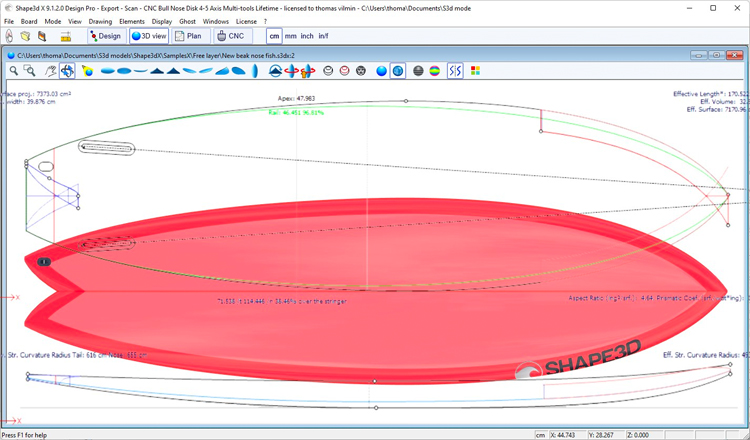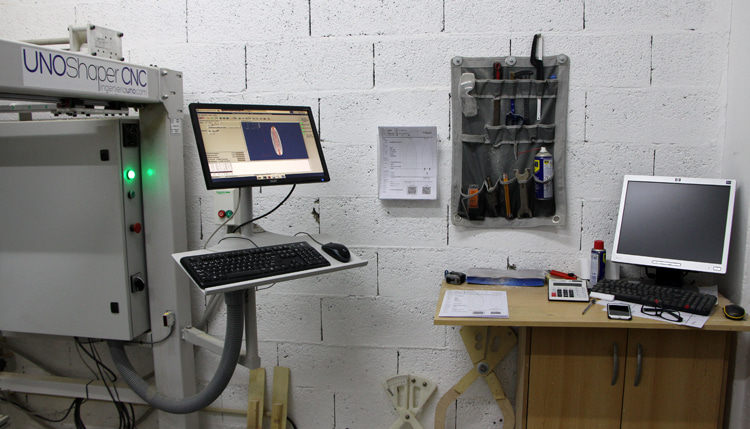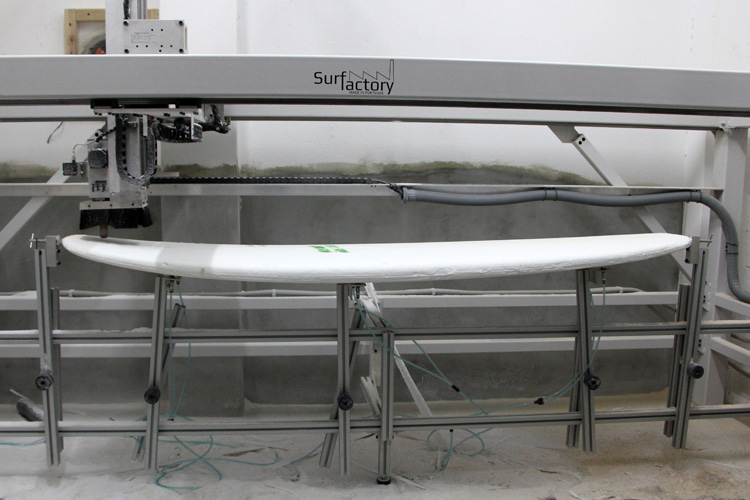Surfboard shaping has evolved dramatically in 100 years. Today, most of the production is partially robotized using high-precision machines.
For decades, boards were entirely handcrafted, but with the advent of automation, the paradigm shifted.
A computer numerical control (CNC) surfboard shaping machine is a unit used to mass-produce surfboards.
It creates a consistent and accurate shape for surfboards, which is crucial for their performance and stability in the waves.
The CNC shaping machine uses a series of cutting tools and precision instruments to carve the foam blank into the desired shape.
The first step in using a surfboard shaping machine is to select the foam blank that will be carved into the shape of the surfboard.
The block is usually made of a type of foam - polyurethane (PU) - which is a strong and lightweight material that is perfect for surfboards.
Once the type of blank has been selected, it is placed on the shaping machine.
The CNC surfboard shaping machine typically consists of a table with various cutting tools attached to it.
Depending on the desired end result, these tools can be adjusted to carve the foam into different shapes. They are powered by an electric motor, which rotates them at high speed.
The shaper can monitor the robot's work and use computer controls to manipulate the cutting tools to carve the foam into the desired shape.
The machine may use a series of different saws to create various aspects of the surfboard, such as the rocker (the curve of the board from nose to tail), the outline (the shape of the board from the top view), and the rails (the edges of the board).
Once the foam has been carved into the desired shape, the shaper will typically sand the board's surface to make it smooth and even.
This step is crucial because it removes any rough spots or blemishes on the deck, bottom, and rails, which could negatively impact the surfboard's performance in the water.
The Design
The CNC machine typically works with a computer program that has the surfboard template or design stored in its database.
The shaper will select the desired template from the database and input the specific measurements they want for that particular board, such as the length, width, and rocker.
The computer program will then control the cutting tools on the shaping machine to carve the foam blank into the specified shape.
Some surfboard shaping machines also have the option for the shaper to create their own custom templates and store them in the computer program for future use.
In this case, the shaper will use a stylus or a mouse to trace the desired shape onto the computer screen, and the computer program will then translate that shape into a series of cutting commands for the shaping machine.
In either case, the surfboard shaping machine follows the instructions and measurements provided by the computer program to carve the foam blank into the desired shape.
This allows the shaper to create a perfectly consistent and accurate shape for each surfboard model.

The CNC Surfboard Shaping Machine Software
There are several software programs that can be adopted to produce the files that are used in CNC surfboard shaping machines.
These programs are known as Computer-Aided Design (CAD) software and typically provide a range of tools and features for designing and modeling surfboards.
Some of the most commonly used CAD software for surfboard design include:
- AKU Shaper: This includes a variety of tools for designing and modeling surfboards in 3D, including a library of shapes and templates, a range of design tools, and the ability to import and export files in a variety of formats. The software also includes means for analyzing surfboard performance and optimizing surfboard shapes based on specific surfing conditions;
- Shape3D: This is another popular CAD software in the surfboard manufacturing industry. It is known for its user-friendly interface, powerful features, and flexibility and is widely used by surfboard manufacturers and shapers around the world;
- BoardCAD: This open-source computer program helps people design and make surfboards. It is designed to make the creative process easy and intuitive and gives the user a 3D view of their design. It also allows shapers to print full-scale templates or get the board CNC-machined. BoardCAD can help shapers learn more quickly by tracking the changes between boards. It won't make someone a great shaper, but it can help a beginner progress faster, and an experienced shaper become even more productive. To get started, take the tutorial to learn more about the workflow and the program's features;
- Rhino Grasshopper 3D: This is a visual programming language and environment used to create 3D models, animations, and design visualizations. It allows users to create complex 3D models and designs by combining mathematical functions, components, and data. The Grasshopper platform is used by architects, product designers, engineers, and artists to create complex 3D models and designs;
- Fusion 360: This is a product development platform that helps people create and work on 3D CAD, CAM, and CAE projects. It can be used to design industrial and mechanical products, test them in simulations, and collaborate on them with other people. It also includes tools for 3D printing, making animations, and creating documents;
- SolidWorks: This is a 3D computer-aided design and product lifecycle management software developed by Dassault Systèmes. It is used for a variety of tasks, such as designing, simulating, analyzing, and manufacturing products. It is used in industries such as aerospace, automotive, and biomedical engineering;
The Time Gains
The speed of a CNC machine shaping a surfboard compared to traditional handmade surfboards can vary depending on several factors, including the size of the board, the complexity of the design, and the experience of the shaper.
However, CNC machines generally shape a surfboard much faster than traditional handmade methods.
CNC machines can complete the shaping process in minutes or hours, whereas traditional hand-shaping methods can take several hours or even days.
This is because CNC machines are automated and can work quickly and efficiently, cutting the foam to a high degree of accuracy.
However, it's worth noting that the speed of the shaping process is one of many factors to consider.
The quality and accuracy of the final product are also important, and in some cases, traditional hand-shaping methods can produce a higher-quality board.
Both traditional hand-shaping and CNC shaping have their own advantages and disadvantages, and the choice between the two methods depends on the specific needs and preferences of the surfboard manufacturer.

The Versatility
The type of blank that can be used with a CNC machine will depend on the specific capabilities of the machine and the desired board type.
However, most CNC machines can work with several surfboard blanks, including expanded polystyrene (EPS) and polyurethane (PU) blanks.
EPS blanks are a popular option for CNC shaping, as they are lightweight and provide good insulation, which can help improve the surfboard's performance.
PU blanks have been typically used for hand-shaping, as they are denser and more challenging to work with than EPS blanks, but they are also frequently cut by these automated devices.
The Investment
The cost of a CNC surfboard shaping machine can vary widely depending on several factors, including the size and complexity of the device, the features and capabilities it offers, and the brand and model.
On average, a basic CNC surfboard shaping machine can cost anywhere from $10,000 to $50,000, while more advanced models can cost upwards of $100,000 or more.
It's worth noting that the cost of a CNC machine is just one part of the overall expenses involved in setting up a surfboard manufacturing business.
Other costs to consider include the cost of materials, such as foam blanks and resin, as well as the cost of equipment and supplies, such as cutting tools, sandpaper, and shaping equipment.
In conclusion, the cost of a CNC surfboard shaping machine can be substantial.
Still, it can also be a valuable investment for surfboard manufacturers looking to increase production efficiency, accuracy, and consistency.
Before purchasing a CNC machine, it's essential to carefully consider the cost, benefits, and overall expenses involved in setting up a surfboard manufacturing business.
Otherwise, you could be losing money when the final product hits the market.
